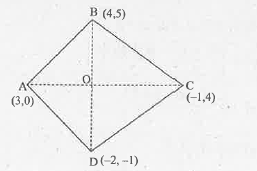Find the angle between the diagonals of parallelogram ABCD whose vertices are A (0, 2), B (2, - 1), C (4, 0) and D (2, 3).Solution in Punjabi
Step by step video & image solution for Find the angle between the diagonals of parallelogram ABCD whose vertices are A (0, 2), B (2, - 1), C (4, 0) and D (2, 3). by Maths experts to help you in doubts & scoring excellent marks in Class 11 exams.
Updated on:21/07/2023Topper's Solved these Questions
Similar Questions
What is the slope of the line whose inclination is :
0∘ ?
View SolutionFind the mean deviation from the mean for the following data : 6,7,10,12,13,4,8,12.
View SolutionFind the radian measure corresponding to the following degree measure 15°
View SolutionIf theta is the angle between the diagonals of a parallelogram ABCD whose vertices are A(0,2),B(2,-1),C(4,0) and D(2,3) Show that tan theta=2
View SolutionShow that the points A(3, 1), B(0, -2), C(1, 1) and D(4, 4) are the vertices of a parallelogram ABCD.
View SolutionABCD is rectangle whose three vertices are B(4, 0), C(4, 3) and D(0, 3). Find the length of one of its diagonal.
View SolutionABCD is a rectangle whose three vertices are B(4, 0), C(4, 3) and D(0, 3). The length of one of its diagonals is
View SolutionThree vertices of a parallelogram ABCD are A(3, 1, 2), B(0, 1, 5) and C(-1, 2, -3) Find the
coordinates of the fourth vertex.
View SolutionΔABC का कोण A ज्ञात कीजिए जिसके शीर्ष A(0, - 1, - 2), B(3, 1, 4) तथा C(5, 7, 1) है।
View SolutionIf A(−2,−1),B(a,0),C(4,b)andD(1,2) are the vertices of a parallelogram, find the values of a and b.
View Solutionकिसी समान्तर चतुभुर्ज ABCD के शीर्षो के निर्देशांक क्रमशः (0,2),(2,−1),(4,0) और (2,3) है। इसके विकर्णो के बीच कोण ज्ञात कीजिए
View SolutionIf A(-2, -1) B(a, 0) C(4, b) and D(1 , 2) are the vertices of a parallelogram. Find a and b
View Solutionಒಂದು ವಜ್ರಾಕೃತಿಯ ಅನುಕ್ರಮ ಶೃಂಗಗಳು (3, 0), (4, 5), (-1, 4) ಮತ್ತು (-2, -1) ಆದರೆ ಅದರ ವಿಸ್ಟೆರ್ಣವನ್ನು ಕಂಡುಹಿಡಿಯಿರಿ.

View SolutionIf two vertices of a parallelogram are (3, 2), (−1, 0) and the diagonals cut at (2, −5) , find the other vertices of the parallelogram.
View SolutionA(0,2),B(−2,−1),C(4,0)andD(2,3) are vertices of parallelogram ABCD. If angle between its diagonal is θ then prove that tanθ=3.
View SolutionA(2, 4, 2), B(1, 2, 1), C(4, 3, -1) and D are the vertices of a parallelogram ABCD. Then find the position vector of the point D.
View Solution
